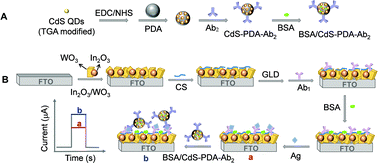Photoelectrochemical sandwich immunoassay of CYFRA21-1 based on In2O3/WO3 type-II heterojunction and CdS quantum dots-polydopamine nanospheres labeling†
Abstract
Using an In2O3/WO3 type-II heterojunction modified fluorine-doped tin oxide (FTO) electrode as the photoanode and CdS quantum dots (QDs)-polydopamine nanospheres (PDA NSs) as the secondary antibody (Ab2) label, the photoelectrochemistry (PEC) sandwich immunosensing of the lung cancer marker CYFRA21-1 was studied. WO3 nanoplates were prepared by a hydrothermal method, In2O3 nanoporous spheres were prepared by a hydrothermal method followed by calcination, and the In2O3/WO3 type-II heterojunction with high PEC activity was prepared by ultrasonic mixing and cast-coating. PDA NSs with a high surface area can be loaded with abundant Ab2 molecules and many CdS QDs with an energy level well matched with the heterojunction, so the photocurrent signal can be amplified by the formation of a sandwich immunostructure. Through the simulation experiments of photoelectrode-modified chitosan films of varying thickness, the effective transport distance of photogenerated charges is preliminarily discussed. Under the optimized conditions, the photocurrent was linear with the common logarithm of CYFRA21-1 concentration from 100 fg mL−1 to 50 ng mL−1, with a limit of detection of 56 fg mL−1 (S/N = 3). The immunoassay of CYFRA21-1 in human serum samples gave satisfactory recovery results.

- This article is part of the themed collection: Analyst HOT Articles 2022


 Please wait while we load your content...
Please wait while we load your content...